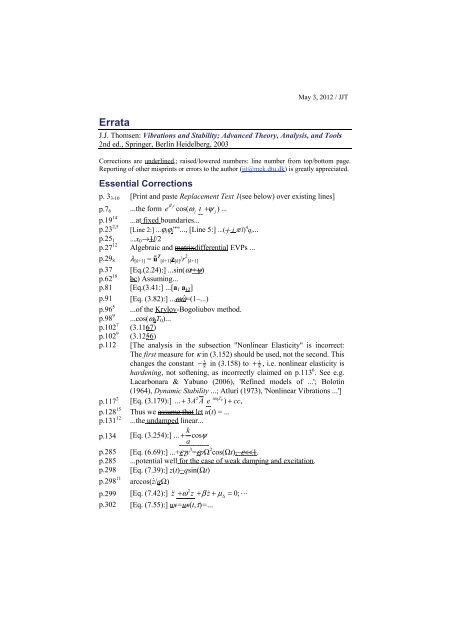Errata
Errata
Errata
Create successful ePaper yourself
Turn your PDF publications into a flip-book with our unique Google optimized e-Paper software.
<strong>Errata</strong><br />
May 3, 2012 / JJT<br />
J.J. Thomsen: Vibrations and Stability; Advanced Theory, Analysis, and Tools<br />
2nd ed., Springer, Berlin Heidelberg, 2003<br />
Corrections are underlined,; raised/lowered numbers: line number from top/bottom page.<br />
Reporting of other misprints or errors to the author (jjt@mek.dtu.dk) is greatly appreciated.<br />
Essential Corrections<br />
p. 33-10 [Print and paste Replacement Text 1(see below) over existing lines]<br />
p.76<br />
j ...the form cos(<br />
t<br />
e j<br />
β<br />
ω t + ψ j ) ...<br />
p.19 14<br />
...at fixed boundaries...<br />
p.23 2,5<br />
p.251<br />
p.27 12<br />
[Line 2:] ...ϕiϕj””..., [Line 5:] ...( j i π/l) 4 q i...<br />
...x0 → 1l/2<br />
Algebraic and matrixdifferential EVPs ...<br />
p.298 λ [k+1] = u T [k+1]z [k]/r 2 [k+1]<br />
p.37 [Eq.(2.24):] ...sin(ωt+ψ)<br />
p.62 18<br />
bc) Assuming...<br />
p.81 [Eq.(3.41:] ...[a1 a12]<br />
p.91 [Eq. (3.82):] ...ωω=(1–...)<br />
p.96 5<br />
...of the Krylov-Bogoliubov method.<br />
p.98 9<br />
p.102<br />
...cos(ω0T0)...<br />
7<br />
(3.1167)<br />
p.102 9 (3.1256)<br />
p.112 [The analysis in the subsection "Nonlinear Elasticity" is incorrect:<br />
The first measure for κ in (3.152) should be used, not the second. This<br />
3<br />
1<br />
changes the constant − 8 in (3.158) to + 8 , i.e. nonlinear elasticity is<br />
hardening, not softening, as incorrectly claimed on p.113 6 . See e.g.<br />
Lacarbonara & Yabuno (2006), 'Refined models of ...'; Bolotin<br />
p.117<br />
(1964), Dynamic Stability ...; Atluri (1973), 'Nonlinear Vibrations ...']<br />
2 2<br />
[Eq. (3.179):] ... + 3A A e 0 0 iωT ) + cc,<br />
p.128 15 Thus we assume that let u(t) = ...<br />
p.131 12<br />
...the undamped linear...<br />
p.134<br />
k<br />
[Eq. (3.254):] ... + cosψ<br />
a<br />
p.285 [Eq. (6.69):] ...+εγy 3<br />
= εpΩ 2 cos(Ωt), ε
2 Vibrations and Stability – <strong>Errata</strong><br />
1<br />
2<br />
p.360 [Eq. (B.20):] u + ... δ ( x−<br />
) /( ρ AL ) + ...<br />
p.361 [Eq. (B.24):] f vdW , i = ...<br />
p.362 5 where...( H −h− l + Ly)<br />
p.3655 β = √ [change to “±“]<br />
<br />
0 ...<br />
T<br />
2<br />
2<br />
/( ρ AL )<br />
ρ .<br />
2<br />
/( AL )<br />
p.366 1<br />
[Eq. (C.5):] c k = T<br />
p.374 [under “a) Clamped-clamped”:] (=cantilever)<br />
p.3751 ...where qθ is the angle...<br />
Replacement Text 1 (page 33-10)<br />
where H0 = F0/k is the zero-frequency deflection, ω is defined by (1.3), and ζ by<br />
(1.5). When Ω ≈ ω large-amplitude resonant vibrations occur, and the natural frequency<br />
ω is also termed the resonance frequency 1 . At sharp resonance, Ω = ω, the<br />
response magnitude is H/H0 = 1/(2ζ), which approaches infinity as the damping<br />
ratio vanishes. Actually the response is strongest for Ω slightly less than ω,<br />
2<br />
2<br />
namely at Ω= ω 1−2ζ≤ ω ≤ω<br />
, where H H0= 1(2ζ 1 − ζ ) . For Ωω<br />
the deflection is in phase with the exciting force, ϕ→0, while at resonance ϕ = π/2,<br />
and as Ωω then ϕ→π (i.e. deflection and force are in antiphase).<br />
Less Essential Corrections<br />
p.XXI 5 X X<br />
p.37 [Add footnote mark: “..resonance frequency 1 p.30<br />
..”]<br />
[Add footnote:] 1 Sometimes resonance frequency is defined as the fre-<br />
2<br />
quency of maximum response (e.g. Harris 1996). Then ω 1−2ζis the<br />
(displacement) resonance frequency, ω is the velocity resonance frequency,<br />
and ω<br />
2<br />
1−2ζis the acceleration resonance frequency.<br />
p.221 ...using and (1.82)...<br />
p.25 2<br />
Solve ... and u (0) = 0 ., and 0 ≤ ζ
p.160 2<br />
p.200 4<br />
p.228 3<br />
p.289 19<br />
Vibrations and Stability – <strong>Errata</strong> 3<br />
...Tcherniak and Thomsen and Tcherniak 2001...<br />
...this bifurcations...<br />
... raised to p = 0.2530<br />
... averaging operatorOperator:averaging...<br />
p.317 13 ...has a finite number of simple zeroes during one period of fast motions.<br />
p.383 6 [Add reference.:] Chen Y (1966) Vibrations: Theoretical Methods.<br />
Addison-Wesley, Reading, Massachusetts.<br />
p.38519 Inman DJ (2001) Engineering Vibrations.
















